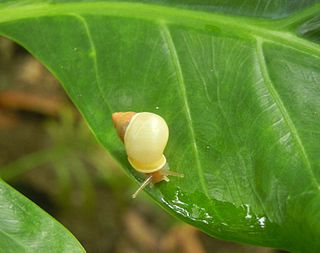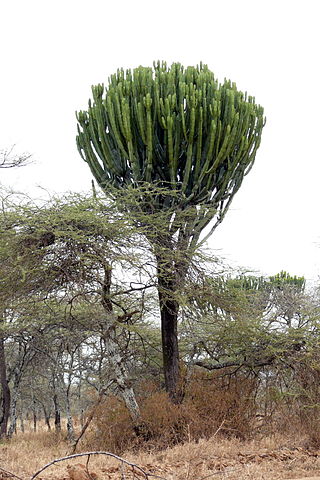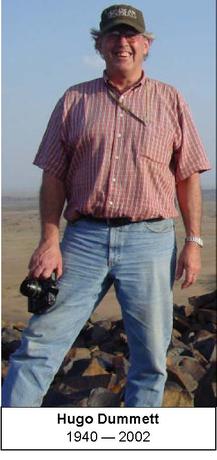
Diamond is a solid form of the element carbon with its atoms arranged in a crystal structure called diamond cubic. Another solid form of carbon known as graphite is the chemically stable form of carbon at room temperature and pressure, but diamond is metastable and converts to it at a negligible rate under those conditions. Diamond has the highest hardness and thermal conductivity of any natural material, properties that are used in major industrial applications such as cutting and polishing tools. They are also the reason that diamond anvil cells can subject materials to pressures found deep in the Earth.

Kimberlite is an igneous rock and a rare variant of peridotite. It is most commonly known to be the main host matrix for diamonds. It is named after the town of Kimberley in South Africa, where the discovery of an 83.5-carat (16.70 g) diamond called the Star of South Africa in 1869 spawned a diamond rush and the digging of the open-pit mine called the Big Hole. Previously, the term kimberlite has been applied to olivine lamproites as Kimberlite II, however this has been in error.

The Ekati Diamond Mine, often simply called Ekati, is Canada's first surface and underground diamond mine and is owned by Burgundy Diamond Mines. It is located 310 km (190 mi) north-east of Yellowknife, Northwest Territories, and about 200 km (120 mi) south of the Arctic Circle, near Lac de Gras. Until 2014, Ekati was a joint venture between Dominion Diamond Mines (80%), Chuck Fipke, and Stewart Blusson, the two geologists who discovered kimberlite pipes north of Lac de Gras. Fipke and Blusson each held 10% stake in the mine, until Fipke sold his share to Dominion. In 2021, Arctic Canadian Diamond Company Ltd. acquired the Ekati Diamond Mine with associated assets and liabilities from Dominion Diamond Mines. In July 2023, Burgundy Diamond Mines purchased full control of Arctic Canadian Diamond Company.

Pandanus is a genus of monocots with some 578 accepted species. They are palm-like, dioecious trees and shrubs native to the Old World tropics and subtropics. The greatest number of species are found in Madagascar and Malaysia. Common names include pandan, screw palm and screw pine. They are classified in the order Pandanales, family Pandanaceae.

Pandanus tectorius is a species of Pandanus (screwpine) that is native to Malesia, Papuasia, eastern Australia, and the Pacific Islands. It grows in the coastal lowlands typically near the edge of the ocean. Common names in English include thatch screwpine, Tahitian screwpine, hala tree and pandanus. The fruit is edible and sometimes known as hala fruit.
Botanical prospecting for uranium is a method of finding uranium deposits either by observation of plant life growing on the surface, or by geochemical analysis of plant material in a process known as Geobotanical prospecting.
Geobotanical prospecting refers to prospecting based on indicator plants like metallophytes and the analysis of vegetation. The concept is speculative or even fringe science. Sitings of commercial mines are invariably guided by geological principles and confirmed by chemical assays.

Canadian diamonds are diamonds which have been mined in any one of the provinces and territories of Canada. Diamond-rich areas were not commercially extracted in Canada until the early 1990s. For the first 60 years of the 20th century, diamonds originated from kimberlite pipes and alluvial deposits in places such as Africa and some from South America. Later, diamond discoveries were made in the Soviet Union. Since the 1990s, major diamond discoveries were made and mining operations began. Canadian diamonds play a large role in the world market of diamonds.
Stewart Lynn "Stu" Blusson, is a Canadian geologist, helicopter pilot, businessman, diamond magnate and philanthropist. He co-discovered billion-dollar Ekati Diamond Mine, 300 kilometres from Yellowknife, Northwest Territories, Canada. He is President of Archon Minerals Ltd. In 2002, Blusson donated key start-up funds necessary for Quest University Canada in Squamish, British Columbia. In 2006, Blusson donated $10 million for the Archon X PRIZE to develop a quick and inexpensive way to sequence the human genome. Blusson had a net worth of $660 million CDN in 2006.

Pandanus utilis, the common screwpine is, despite its name, a monocot and not a pine. It is native to Madagascar and naturalised in Mauritius and the Seychelles.

The fat Guam partula or humped tree snail, scientific name Partula gibba, is an endangered species of air-breathing land snail, a terrestrial gastropod mollusk in the family Partulidae.

Pandanus multispicatus is a species of plant in the family Pandanaceae, one of several Pandanus species that are endemic to the Seychelles.

Euphorbia candelabrum is a succulent species of plant in the family Euphorbiaceae, one of several plants commonly known as candelabra tree. It is endemic to the Horn of Africa and eastern Africa along the East African Rift system. It is known in Ethiopia by its Amharic name, qwolqwal, or its Oromo name, adaamii. It is closely related to three other species of Euphorbia: Euphorbia ingens in the dry regions of southern Africa, Euphorbia conspicua from western Angola, and Euphorbia abyssinica, which is native to countries including Sudan, Eritrea, Djibouti, Ethiopia and Somalia.
The Mountain Lake cluster consists of two diatremes or volcanic pipes in Northern Alberta, Canada. It was emplaced during a period of kimberlite volcanism in the Late Cretaceous epoch.

Hugo T. Dummett (1940–2002) was a South African mineral-exploration geologist who is best known for his role in the discovery of the Ekati Diamond Mine in the Barren Lands of Canada's Northwest Territories. Dummett has been described as "the brains, the ideas and the energy" behind the discovery of Ekati, which led to the creation of a new Canadian diamond-mining industry.

Pandanus odorifer is an aromatic monocot species of plant in the family Pandanaceae, native to Polynesia, Australia, South Asia, and the Philippines, and is also found wild in southern India and Burma. It is commonly known as fragrant screw-pine.
The Buffalo Head Terrane (BHT) is a terrane in the western Canadian Shield in northern Alberta. It is covered by 1,600 m (5,200 ft) of Devonian and Cretaceous sediments and its centre is intruded by the 88–86 Ma kimberlites of the diamondiferous Buffalo Head Hills kimberlite province.
The geology of Liberia is largely extremely ancient rock formed between 3.5 billion and 539 million years ago in the Archean and the Neoproterozoic, with some rocks from the past 145 million years near the coast. The country has rich iron resources as well as some diamonds, gold and other minerals in ancient sediment formations weathered to higher concentrations by tropical rainfall.

The karuka is a species of tree in the screwpine family (Pandanaceae) and an important regional food crop in New Guinea. The nuts are more nutritious than coconuts, and are so popular that villagers in the highlands will move their entire households closer to trees for the harvest season.
Pandanus connatus is a species of plant in the family Pandanaceae native to northern Madagascar.












